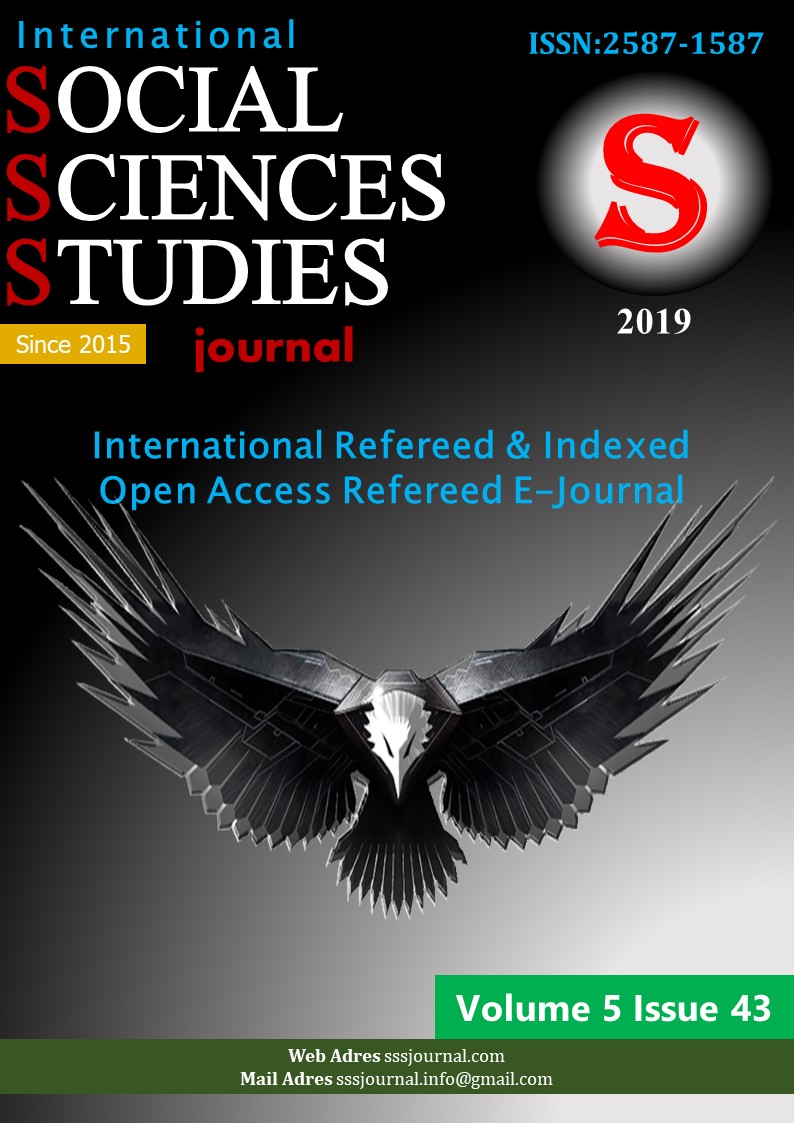Author :
Abstract
Bir ekonomi için en önemli makroekonomik göstergelerden biri de enflasyondur. Son dönemde Türkiye ekonomisinde yaşanan yüksek enflasyon olgusunun nedenleri tartışılmaktadır. Literatürde enflasyonun nedenleri konusunda farklı görüşler yer almaktadır. Bunlardan biri de para arzının kontrolsüz bir şekilde artışıdır. Türkiye'de son dönemde yaşanan enflasyonun da bu sebeple ortaya çıktığı iddia edilmektedir. Bu amaçla para arzı ile enflasyon arasındaki ilişki, 2001-2018 dönemi Türkiye ekonomisi için test edilmek istenmiştir. Çalışmada enflasyonu temsilen, Tüketici Fiyat Endeksi (TÜFE); Para arzını temsilen, Dolaşımdaki Para Miktarı (M0) değişkenleri kullanılmıştır. İlgili veriler T.C. Merkez Bankası (TCMB) ve Türkiye İstatistik Kurumu (TUİK) web sayfalarından derlenmiştir. Ampirik analiz ARDL Sınır Testi Modeli kullanılarak yapılmıştır. Türkiye Ekonomisi için elde edilen sonuçlara göre, sadece kısa vadede para arzı artışı enflasyona neden olmaktadır. Uzun vadede para arzı artışı ile enflasyon arasında bir ilişki bulunamamıştır.
Keywords
Abstract
One of the most important macroeconomic indicators for an economy is inflation. The reason for the high inflation experienced in Turkey's economy in recent cases are discussed. There are different opinions about the causes of inflation in the literature. One of them is the uncontrolled increase in money supply. Inflation experienced in Turkey in recent times has been claimed that therefore arise. For this purpose, the relationship between money supply and inflation has been examined. 2001-2018 period were tested for Turkey's economy. Consumer Price Index (CPI), representing inflation in the study; The money in circulation (M0) variables were used to represent the money supply. Relevant data, are obtained from the databases of Central Bank of Turkey (CBRT) and Turkey Statistical Institute (TUIK). The empirical analysis is performed using ARDL Bounds Test. According to the results obtained for Turkish economy; the rise in supply of money increases inflation in the short run. In the long run, there is no relationship between money supply and inflation.
Keywords
- Akel, V. & Sümeyra G. (2014). "Döviz Kurları İle Bıst Sanayi Endeksi Arasındaki Eşbütünleşme İlişkisi: Bir ARDL Sınır Testi Yaklaşımı", Erciyes Üniversitesi İktisadi ve İdari Bilimler Fakültesi Dergisi, 44: 23-41.
- Babatunde, M. A. & Muhammed S. I. (2011). "Money Supply, Inflation And Economic Growth In Nigeria", Asian-African Journal of Economics and Econometrics, 11 (1):147-163.
- Bello, M. Z. & Mubarak S. A. (2013). "Reationship between Inflation, Money Supply, Interest Rate and Income Growth (Rgdp) in Nigeria 1980-2010 an Empirical Investigation", Journal of Economics and Sustainable Development, 4(8):7-13.
- Bozkurt, C. (2014). "Money, Inflation and Growth Relationship: The Turkish Case", International Journal of Economics and Financial Issues, 4(2):309-322
- Chaudhary, M. A. & Naved, A.(1995). “Money Supply, Deficit, and Inflation in Pakistan”, The Pakistan Development Review, 34 (4):945-956.
- Glauco D. V. & Abbott, A. (2004). “Real Exchange Rate Volatility and US Exports: An ARDL Bounds Testing Approach”, Economic Issues, 9(1): 69-78.
- Denbel, F. S.; Yilkal A.W. & Adugna, R.T. (2016). “The Relationship Between Inflation, Money Supply and Economic Growth in Ethiopia: Co integration and Causality Analysis”, International Journal of Scientific and Research Publications, 4(1):556-565.
- Dickey, D. A. & Fuller A.W. (1979). "Distribution of the Estimators for Autoregressive Time Series With a Unit Root", Journal of the American İstatistikal Association, 74: 427-431.
- Eğilmez, M. (2019). “Merkez Bankası’nın Bastığı Paraların Enflasyona Etkisi Oldu Mu?”, Kendime Yazılar, http://www.mahfiegilmez.com/2019/01/merkez-bankasnn-bastg-paralarn.html, 18.01.2019
- Gatawa M. ; Akinola, A. & Olarinde, M. O. (2017). “Impact of Money Supply and Inflation on Economic Growth in Nigeria (1973-2013)”, Journal of Economics and Finance (IOSR-JEF), 8(3): 26-37.
- Ho-Fung, H. & Thompson, D.(2016). "Money Supply, Class Power, and Inflation: Monetarism Reassessed", American Sociological Review, 81(1): 447-466.
- İslatince, H. (2017). “Para Arzı ve Enflasyon İlişkisi: Türkiye İçin Nedensellik Analizi (1988-2016)”, Anadolu Üniversitesi Sosyal Bilimler Dergisi, 17(3): 43-56.
- Kaufmann, S. (2007). “Capturing the Link between M3 Growth and Inflation in the Euro Area – An Econometric Model to Produce Conditional Inflation Forecasts”, Monetary Policy & the Economy, Oesterreichische Nationalbank (Austrian Central Bank), 2:93-108.
- LİN, M.T. (1967). “Keynes's Theory And Inflation”, Kansas State University, Kansas, (A Master's Report):1-48.
- Mbongo, J. E.; Mutasa, F. & Msigwa, R. E. (2014). “The effects of money supply on inflation in Tanzania”, Economics, 3(2):19-26.
- Mccallum, B. T. & Nelson, E. (2011). “Money and Inflation: Some Critical Issues”, (in Friedman, Benjamin. M., and Michael Woodford eds.), Handbook of Monetary Economics, 3:97-153.
- Orhan, O. Z. & Erdoğan, S. (2015) Genel Ekonomi, Umuttepe Yayınevi, Kocaeli.
- Patinkin, D. (1969). “The Chicago Tradition, The Quantity Theory, And Friedman”, Journal of Money, Credit and Banking, 1(1): 46-70.
- Perron,P. (1989). “The Great Crash, the Oil Price Shock and the Unit Root Hypothesis”Econometrica, 57:1361-1401.
- Pesaran, M.; Hashem, S. Y. & Smith, R. J. (2001). “Bounds Testing Approaches to the Analysis of Level Relationships,” Journal of Applied Econometrics, 16: 289-326.
- Sağlam, M. & Uğurlu, E. (2013). “Kamu Açıkları, Parasal Büyüme ve Enflasyon İlişkisi: Türkiye Örneği (1983-2008)”, Finans Politik & Ekonomik Yorumlar, 50 (576):71-84.
- Sean, M.; Pastpipatkul, P. & Petchaluck, B. (2018). " Money Supply, Inflatıon And Exchange Rate Movement: The Case Of Cambodıa By Bayesıan Var Approach", Journal of Management, Economics, and Industrial Organization, 3(1): 63-81.
- Su, C.W.; Fan,J.J.; Chang H.L. & Xiao, L.(2016). “Is there Causal Relationship between Money Supply Growth and Inflation in China? Evidence from Quantity Theory of Money” Review of Development Economics, 20(3):702-719.
- TCMB; (2019). Türkiye Cumhuriyet Merkez Bankası, Resmi İnternet Sayfası, https://evds2.tcmb.gov.tr ,08.02.2019
- TÜİK; (2019). Türkiye İstatistik Kurumu, Resmi İnternet Sayfası, http://tuik.gov.tr/UstMenu.do?metod=temelist, 26.02.2019
- Uysal, Y. (2007). “Türkiye’de Enflasyon: Sektörel Kaynakları ve İç Ticaret Hadleri”, Finans Politik& Ekonomik Yorumlar, 44(508): 21-34.
- Yan-Liang, W. (2012). “Relationship Research on Money Supply, Economic Growth and Inflation”, Journal of Convergence Information Technology (JCIT), 7(11): 20-28.
- Yıldırım, Ç. D. & Çevik, İ. E. (2018). “Finansal Kriz Sonrası Dönemde E7 Ülkelerinde Para Politikası Refah İlişkisi”, International Congress of Management, Economy and Policy, Spring, Istanbul.





